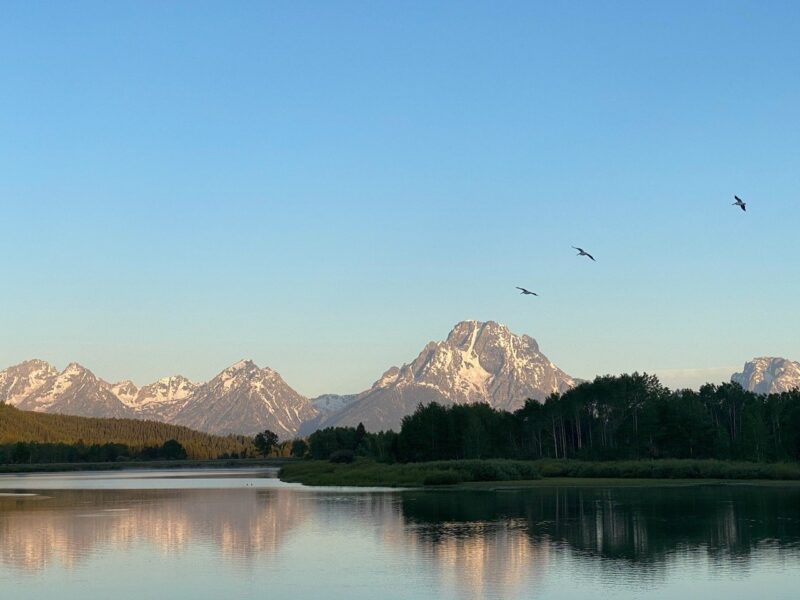Uncertainty Looms for Snake River as Bureau of Reclamation Announces Plan to Reduce Water Flow
Locals, agencies and businesses battle to keep iconic segment of river at minimum levels
- Published In: Other News & Features
- Last Updated: May 11, 2023

Grand Teton National Park’s iconic Oxbow Bend is a lush riparian ecosystem and critical habitat for waterfowl, aquatic insects, fish and mammals of all sizes. (Courtesy photo from Kristin Combs)
By Melissa Thomasma
Special to the Wyoming Truth
One of the most iconic perspectives on the Tetons — the range reflected in the mirror-like surface of Oxbow Bend on the Snake River — is on the brink of being drained to a muddy puddle.
As the broader West navigates the runoff of an above-average snowpack, the Bureau of Reclamation (BOR) announced plans to reduce water flow out of Jackson Lake Dam by over 80% — from 280 cubic feet per second (cfs) to 50 cfs for up to eight weeks.
A trickle so miniscule hasn’t been seen since 1981. And it’s a move that has river and wildlife advocates concerned.
“This drastic change in water operations by the Bureau of Reclamation with extremely short notice has made this situation particularly challenging,” Brian Nesvik, Wyoming Game & Fish Department Director, said in a recent statement.

On May 5, the bureau announced its intention to begin flow reduction on May 10. But negotiations among local organizations, regional agencies and state representatives have delayed the start date—and it’s unclear for how long.
The decision stems from the bureau’s effort to retain as much water as possible in the Upper Snake River Basin, both to mitigate the flow into reservoirs downstream that are at or near capacity, as well as ensure that the resource can be utilized later in the season by those with rights to it.
The possibility looms large: Even after the State of Wyoming decided to use all of its Upper Snake River Basin water rights — purchased in the 1990s — to keep the flow steady for now, the amount covered by the rights will run out before the eight weeks are up.
Additionally, this move leaves Wyoming with zero rights in reserve should the flows again need protection from a steep cut in the fall.
“With the level of snow pack the Jackson area received this winter, it was surprising to us to see a proposed reduction of flows,” Alan Osterland, Chief of Fisheries for Wyoming Game & Fish, told the Wyoming Truth. “The Bureau has indicated that this is a unique situation. However, reduction of flows down to 50 cfs could have impacts to the ecosystem directly downstream of the dam.”
The minimum flow for the waterway out of Jackson Lake Reservoir is 280 cfs to maintain the fishery’s health — a baseline established by a study performed in 1987, according to the department. Even a short period of water flowing at 50 cfs could be problematic.
“This decision by [the bureau] has the potential to impact spawning native fish, anglers and recreational users and visitors,” said Nesvik. “Reducing flows during a year when we have significantly more water available than normal is hard to comprehend.”
Nesvik noted that the 4.5 mile stretch of river directly below the dam is critical habitat for Snake River cutthroat trout, myriad shore birds, wildlife and the bluehead sucker — a species of greatest conservation need.
Boots Allen, the senior guide for local fishing company Snake River Angler, said complex relationships among aquatic invertebrates, species of fish, birds and other wildlife, make it difficult to predict the impact of the plan.
“It’s unclear how it would ultimately impact trout,” Allen told the Wyoming Truth. He said that in the 1970s, when flows were more often reduced to such low numbers, populations of aquatic insects were essentially decimated. In turn, cutthroat trout populations suffered.
“Since we’ve had more consistent flows year-round,” he said, “the fish population has become much healthier.”
Allen believes that if the water flow drops to 50 cfs, there’s a decent chance the river would rebound reasonably well. Still, he’s adamantly against the plan: “The aquatic ecosystem is likely resilient enough to weather this one time, but it’s certainly not good. And it’s not sustainable long term.”
Representatives from Grand Teton National Park declined comment, and representatives from the Bureau of Reclamation did not respond to requests for an interview.
National park gem at risk
One of the locations most threatened by the decrease in river flow is Oxbow Bend, a deep, slow-moving segment of waterway that offers pristine riparian habitat for bears, elk, waterfowl and more. It’s a popular location for photographers and tourists alike, and a frequent stop on professionally guided wildlife safari-style tours of the park.
Taylor Phillips — owner of Jackson Hole EcoTour Adventures and wildlife guide who frequently shepherds guests on such tours — has spearheaded a petition on Change.org that asks U.S. Secretary of the Interior Deb Haaland to intervene and lead the charge to develop a more sustainable management strategy.
“Countless visitors and photographers from around the world seek out the Oxbow Bend for its scenic views, iconic mountain reflections and unmatched wildlife viewing opportunities,” the petition reads. “Without adequate flows, the Oxbow dries up, driving animals away, disappointing visitors who are on a ‘once in a lifetime’ trip, and decreasing the overall scenic and ecological value of the area.” So far, the petition has racked up nearly 700 signatures.
Similarly, leaders of the Snake River Fund — a Jackson-based nonprofit that promotes stewardship of the waterway — are encouraging citizens to contact U.S. Senator John Barrasso (R-Wyo.) to express their concern and advocate for a holistic, sustainable solution.
Executive Director Orion Hatch said the Snake River Fund is cooperating with individual stakeholders and a variety of government agencies and departments.
“There’s no easy solution here; it’s quite complicated,” he said. “The idea is to form a Snake River Headwaters Group that bridges gaps in communication and goals.”
Stakeholders from myriad perspectives agree that a collaborative approach to developing a solution is key.
“The State of Wyoming is committed to using what available water it has in its account to keep flows at 280 cfs as long as possible,” said Osterland, of Wyoming Game & Fish. “The State Engineer’s Office, Wyoming Water Development Office and Game & Fish remain committed to working with [the bureau] to maintain flows at levels that will avoid negative impacts to the fishery. State leaders are also working in good faith with senior officials in the Department of Interior to find a mutually agreeable path forward that protects critical wildlife habitats.”
Added Hatch: “This fiasco has revealed the unsustainability of the current management paradigm. Keeping the flow at 280 cfs this year would be avoiding a catastrophe, but it’s not a win. We need a framework that balances downstream needs with ecosystem priorities.”













